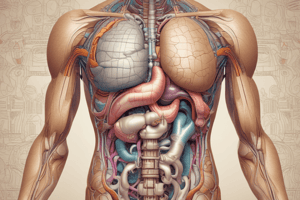Podcast
Questions and Answers
What is the region where mechanical digestion occurs?
What is the region where mechanical digestion occurs?
- Esophagus
- Large Intestine
- Mouth (Oral Cavity) (correct)
- Small Intestine
What is the function of the tongue?
What is the function of the tongue?
Organ that mixes food in the mouth
What do salivary glands produce?
What do salivary glands produce?
Enzymes that begin carbohydrate digestion
What is the pharynx?
What is the pharynx?
What is the esophagus?
What is the esophagus?
What anatomical region is responsible for protein digestion?
What anatomical region is responsible for protein digestion?
What does the cardiac sphincter connect?
What does the cardiac sphincter connect?
What is the primary function of the small intestine?
What is the primary function of the small intestine?
What major functions does the large intestine perform?
What major functions does the large intestine perform?
What is the rectum's function?
What is the rectum's function?
What is the anus?
What is the anus?
What does the alimentary canal include?
What does the alimentary canal include?
What is chyme?
What is chyme?
What is an enzyme?
What is an enzyme?
What is the liver's role in digestion?
What is the liver's role in digestion?
What is the function of the gall bladder?
What is the function of the gall bladder?
What does the pancreas produce?
What does the pancreas produce?
What is the appendix?
What is the appendix?
What are villi?
What are villi?
What are microvilli?
What are microvilli?
Which of the following are accessory organs in the digestive system?
Which of the following are accessory organs in the digestive system?
What are the four stages of the digestive system?
What are the four stages of the digestive system?
What is peristalsis?
What is peristalsis?
What is the difference between mechanical digestion and chemical digestion?
What is the difference between mechanical digestion and chemical digestion?
Flashcards are hidden until you start studying
Study Notes
Digestive System Overview
- The digestive system includes the alimentary canal, which runs from the mouth to the anus: mouth > pharynx > esophagus > stomach > small intestine > large intestine > anus.
- Four stages of digestion: ingestion, digestion, absorption, and elimination.
Mouth and Initial Digestion
- The mouth (oral cavity) initiates mechanical digestion, breaking food into smaller pieces.
- The tongue mixes food with saliva, aiding in the digestive process.
- Salivary glands produce enzymes, particularly amylase, which begin carbohydrate digestion.
Pharynx and Esophagus
- The pharynx serves as a common passage for food and air.
- The esophagus acts as a food chute with no digestive or absorptive functions.
Stomach Functions
- The stomach is the anatomical region where mechanical digestion and initial protein digestion occur.
- Takes approximately 4 hours to empty after a balanced meal; may take up to 6 hours for fatty meals.
- Cardiac sphincter marks the junction of the stomach and esophagus.
Small Intestine
- The small intestine is the primary site for nutrient absorption and is also where the stomach empties its contents.
- Receives pancreatic juice and bile, which aid in digestion.
- Villi and microvilli increase surface area for absorption.
Large Intestine
- Functions mainly for water absorption and feces formation.
- Contains four major parts: cecum, appendix, colon (ascending, transverse, descending, sigmoid), and rectum.
- The cecum is where indigestible food enters; the appendix can become inflamed.
Rectum and Anus
- The rectum stores feces until excretion.
- The anus is the opening for fecal expulsion.
Chyme and Enzymes
- Chyme is the semi-liquid food mixture after digestion in the stomach, entering the small intestine via the pyloric sphincter.
- Enzymes act as catalysts for biochemical reactions, enhancing absorption and digestion.
Accessory Organs
- Accessory digestive organs include salivary glands, liver, gall bladder (stores bile), and pancreas (produces digestive enzymes and neutralizes stomach acid).
Peristalsis
- Peristalsis consists of rhythmic wave-like contractions that move food through the digestive tract, starting from the esophagus and continuing through to the large intestine.
Digestion Types
- Mechanical digestion involves preparing food for chemical digestion, starting in the mouth and continuing in the stomach.
- Chemical digestion involves enzymatic breakdown of food into absorbable molecules, occurring in the mouth, stomach, and small intestine.
Studying That Suits You
Use AI to generate personalized quizzes and flashcards to suit your learning preferences.




